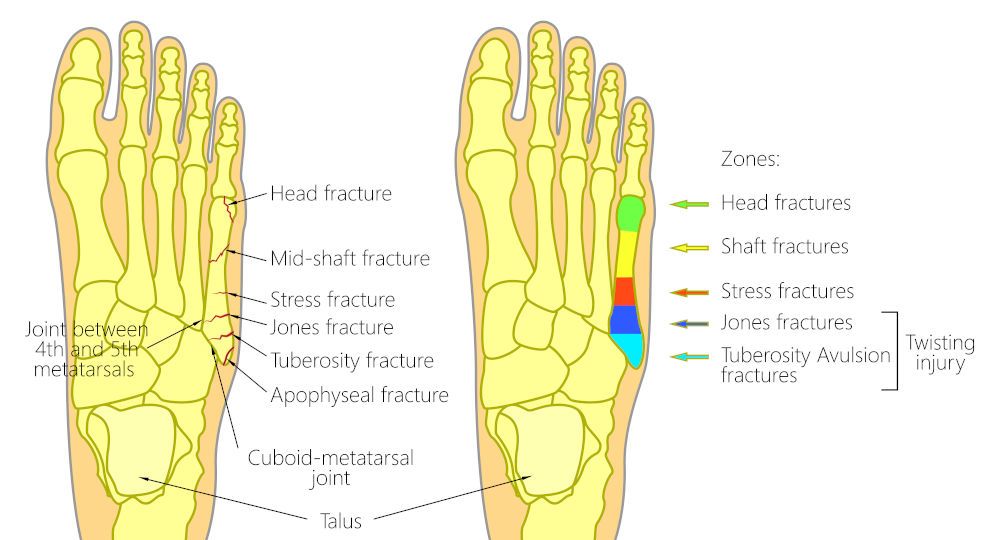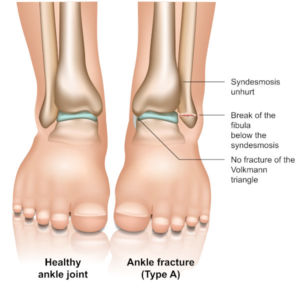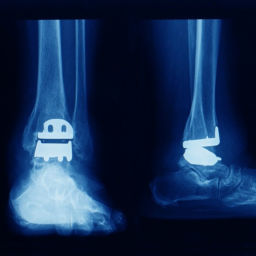
When you hear that someone has a foot fracture, this can refer to many different bone breakages. Ankle fractures, heel bone fractures, and metatarsal fractures are just a few types of foot and ankle fractures. When the foot or ankle is overused, this can also result in stress fractures.
With so many different types of fractures of the foot, it can be hard to keep up. This article will explain each type of fracture, so you have the information you need.
Ankle Fractures

Foot bone fractures occur in all sorts of environments. There are a few common symptoms to be aware of. These include protruding bones (known as a compound fracture), inability to place weight on the ankle, tenderness, pain, swelling, and bruising.
If you suspect a fracture in the foot or ankle, a podiatrist will ask you about symptoms before deciding on the best plan of action. X-rays may be needed to see how bad the injury is. In other cases, an MRI or CT scan will be needed.
Fracture type will determine the best method of treatment. In most cases, a splint or cast will be used followed by a regimen of physical therapy.
Heel Bone Fractures
The calcaneus or heel bone is below the ankle joint. It is the largest tarsal bone. It also makes up the subtalar joint which creates lateral movement in the hindfoot, which is required for balance, especially on rugged terrain.
This broken bone is a bit less common and can be attributed to many sources. For instance, if you fall from a great height and land on your feet, this fracture can occur. When putting weight on the foot during an experience like this, the heel can become shorter and wider.
Fractures, including those in the heel bone, have a variety of symptoms. Some of the most common are the inability to put weight on the heel, bruising, swelling, and pain.
For a heel bone fracture, you’ll be asked about your symptoms to determine what the best treatment method is for you. CT scans and x-rays may be needed to investigate the fracture further.
Treatment methods vary based on the type and seriousness of the fracture. Some options include wearing a brace or cast, having surgery, or taking part in physical therapy.
Metatarsal Fractures
Every foot has five metatarsal bones that connect the toes to the ankle. These bones help create better balance when standing or walking by supporting the foot. These are common fractures and are especially common in people who play football.
This fracture may occur when the foot is kicked or stepped on, or a fall occurs. Even a sharp twist to the foot can cause a fracture. Overuse of the bones also creates stress fractures, which are small cracks in the bone.
When the injury occurs, a crack noise can sometimes be heard. There will be bruising and swelling as well as tenderness and pain. Movement may be restricted, and it can be challenging to place weight on the foot. In some cases, the pain will get better after one to two hours.
For fractures involving the bone of the lower leg, diagnosis starts by talking with a podiatrist. Symptoms will be talked about to choose the best treatment option. CT scans and x-rays may also be used as needed.
If the fracture is compound, painkillers, ice packs, and plaster casts may be needed. In other cases, surgery is required to prevent long-term issues. This is most common if there are displaced bones. The fracture will be repaired, and you may need to engage in physiotherapy to ensure proper healing.
Final Thoughts
If you believe you may have an ankle or foot fracture, it’s important to see a podiatrist as soon as you can. This ensures you get the proper care you need to avoid any future issues with your feet and ankles. Work with a specialist who treats all types of foot fractures for the best results.
We are located in South East and West Florida, with foot clinics in Vero Beach, Weston, Jupiter, Palm City, St. Petersburg, Tampa and Fort Myers. For a complete list please visit our locations page.









